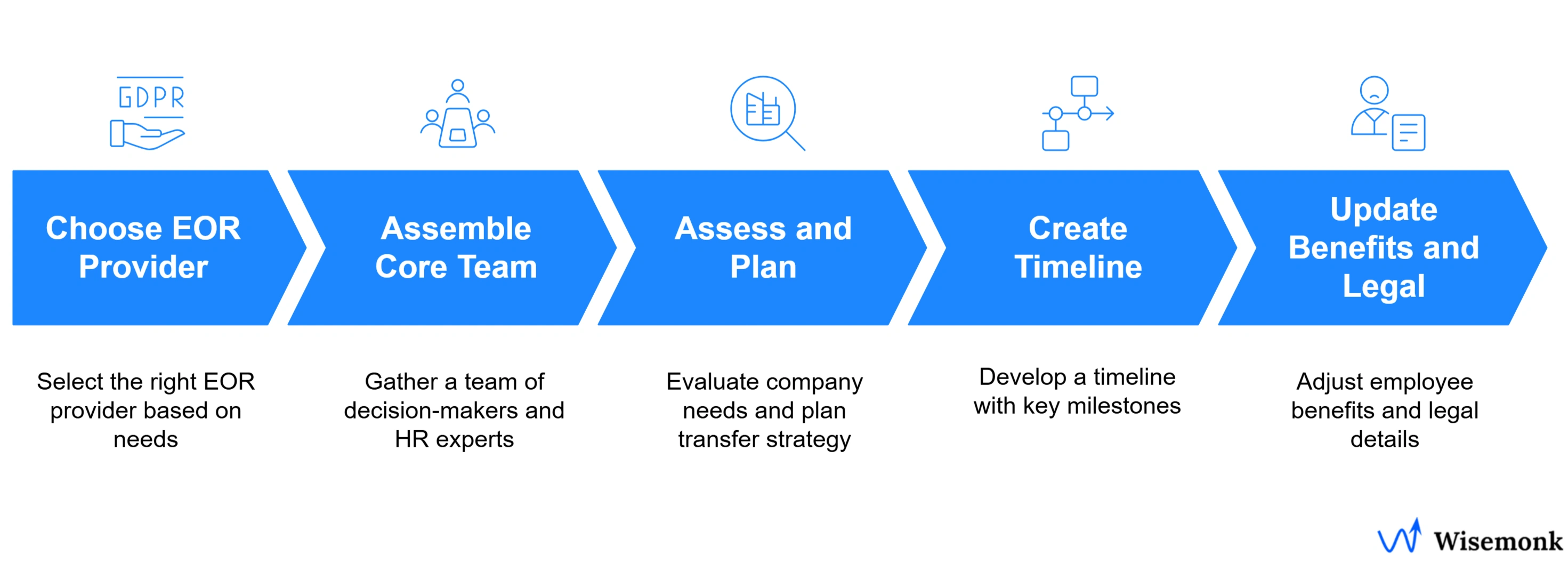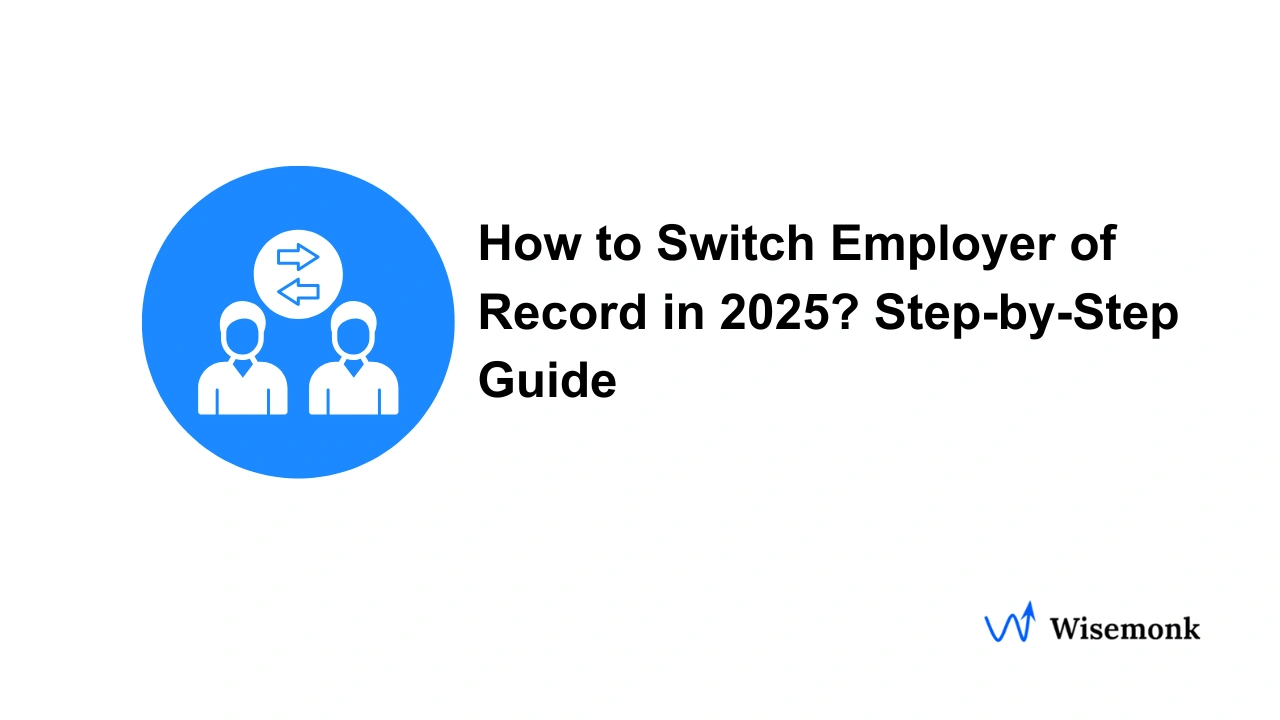- An Employer of Record (EOR) is a third-party organization that becomes the legal employer for your international workforce, handling all employment responsibilities, including payroll, taxes, compliance, and benefits administration, while you maintain operational control.
- Switching Employer of Record involves choosing the right provider, aligning your teams, setting clear timelines, and keeping everyone informed throughout the transition.
- When picking an EOR provider, make sure they understand your needs, have global hiring experience, and offer excellent customer support for a better partner experience.
- The challenges faced by global employers when switching EOR includes data security risks, compliance issues & increased admin workload.
Need help with your EOR transition? Contact us today!
Discover how Wisemonk creates impactful and reliable content.
Thinking about switching your EOR provider? Whether you’re dealing with hidden fees, compliance headaches, or just need better local expertise, the switch doesn’t have to be complicated. This guide is for businesses already working with an EOR but looking for something better. Whether you’re a startup expanding globally, a small business scaling up, or a large company seeking smoother global hiring and cost control, this article is for you.
We’ll walk you through why companies switch EOR providers, the exact steps you need to take, and how to keep everything compliant during the transition. Let’s dive in.
How to switch Employer of Record (EOR)? Step-By-Step [toc=Steps to Switch EOR]
Switching your Employer of Record (EOR) is a structured process, but with the right approach, you can make the transition smooth and hassle-free.
Here’s a step-by-step guide to ensure you cover all your bases and stay compliant.

Step 1: Choose the Right Employer of Record Provider
Choosing the right EOR provider is the most crucial step. You’ll want to ensure they offer the global coverage and local compliance expertise needed for your business. Compare different providers’ services, pricing structures, and their ability to meet your employee benefits and payroll needs. Don't forget to check if they specialize in the countries you're hiring in.
Read more: EOR Vendor Selection: Provider Evaluation Framework & Best EOR Services for Startups in 2025
Step 2: Assemble Your Core Team
Gather a team of decision-makers and HR experts who can evaluate the switch carefully. This team should include members from compliance, payroll, and legal departments to make sure the transition goes smoothly. Having a core team ensures a clear, strategic approach to the switch.
Step 3: Assess and Plan Your Transfer Strategy
Before diving into the switch, take the time to assess your company’s needs. Define your strategy based on factors like company size, employee count, and the countries involved. A tailored plan will help ensure you’re prepared for every step and that no details are overlooked, such as employee records, payroll schedules, and compliance documentation.
Step 4: Create a Clear, Actionable Timeline
It’s essential to create a timeline for the entire process. This timeline should include key milestones like signing the new EOR contract, completing the data transfer, and ensuring employees are onboarded smoothly. A clear, actionable timeline helps avoid delays and ensures you meet all compliance deadlines.
Step 5: Update Employee Benefits and Legal Details
Updating employee benefits and legal details is a key part of a smooth transition. This includes adjusting employment agreements, updating employee contracts, and ensuring accrued benefits are carried over seamlessly. Make sure employees are informed and the changes don’t disrupt their employee satisfaction.
Step 6: Implement Internal Communication and Gather Employee Feedback
Effective internal communication is crucial during this process. Keep employees informed about the transition timeline, what to expect, and how it affects them. Encourage feedback to address any concerns early, ensuring employees feel supported during the change.
Step 7: Execute the Transition and Finalize the Offboarding Process
The final step involves executing the transition while finalizing legal matters and admin details. Ensure all compliance documentation is complete and that any loose ends from your current EOR provider are wrapped up. This includes transferring employee data, completing any termination requirements, and confirming that employees are paid correctly.
Why do companies switch Employer of Record providers?[toc=Why Companies Switch EOR]
Companies choose an Employer of Record (EOR) when they want to expand globally without the hassle of setting up a local legal entity. An EOR handles all the legal employment, payroll, and compliance tasks, making it easier to hire employees across borders.
But sometimes, a company needs to switch providers due to various challenges. Here’s why:
- Service Limitations: Your current EOR provider might not offer the services you need as your business grows. Whether it’s handling international employees, offering the right employee benefits, or scaling payroll, limitations in service can push you to find a better fit.
- Limited Country Coverage: If your current EOR doesn’t have a strong presence in the countries where you’re expanding, it can hinder your global workforce growth. Lack of local knowledge or coverage in new regions may force you to look for a provider with better global reach.
- Compliance Issues: An EOR provider must stay updated with local tax laws, labor regulations, and employment agreements. If your provider isn’t meeting these standards, you risk legal compliance issues. Compliance failure can be costly, making it one of the biggest reasons to consider switching.
- Cultural and Operational Misalignment: As your business grows globally, you may find that your EOR provider doesn’t align with your company culture or operational needs. Different management styles, language barriers, or a lack of employee support can lead to frustration for both you and your workers. A new EOR can offer a better cultural fit and smoother operations.
- Customer Support and Pricing Issues: Poor customer support or hidden fees can be a dealbreaker. If your EOR provider doesn’t respond quickly to questions or if you’re faced with unexpected costs, it can disrupt business operations. Switching to a provider with transparent pricing and better customer support can help you avoid these issues.
Switching an EOR provider can solve these problems and help your company grow smoothly. In the next section, we’ll look at what to look for in your new Employer of Record service provider.
What to look for in your new EOR service provider?[toc=Considerations]
When switching your EOR provider, it’s important to evaluate more than just basic features. You need a partner who can scale with your business and offer solid local expertise and global coverage. Here’s what to look for:

Local Entity Ownership and Global Coverage
Look for an EOR that has local entity ownership in the countries you operate in. This is crucial for certain markets where only a local entity can legally employ workers. A provider with global coverage but also a deep understanding of local laws will ensure you stay compliant in every region.
Expertise in Your Industry and Geography
Different industries have different compliance and operational challenges. Make sure your new EOR provider has experience in your specific field. Whether you’re in tech, healthcare, or finance, their knowledge of industry-specific regulations will keep your business in the clear.
Transparent Pricing and Service Flexibility
Transparent pricing is essential. Make sure there are no hidden fees or surprise costs. Understand how the provider charges for things like employee benefits, payroll management, and other services. Additionally, ensure the provider offers the flexibility to adapt as your business needs change over time, whether that’s expanding into new regions or adjusting services.
Choosing the right EOR solution isn’t just about ticking boxes. It’s about finding a provider that fits your specific needs. In the next section, we’ll cover common mistakes to avoid when making the switch.
What are the common mistakes to avoid when switching EOR providers[toc=Mistakes to Avoid]
Based on our extensive experience guiding companies through how to switch Employer of Record, the top mistakes we see are choosing providers with weak local compliance expertise, failing to confirm that the current EOR owns legal entities in your target countries, and overlooking hidden or unclear pricing that can lead to unexpected costs. Avoiding these pitfalls is essential for a smooth global employment.
- Weak Compliance Knowledge: One of the biggest risks when switching EORs is choosing a provider with weak compliance knowledge. If your new provider doesn't understand local employment laws or tax regulations, your business could face legal risks or hefty fines. For example, a company switched EORs, but the new provider didn’t follow local tax laws, leading to a costly audit and delayed payroll.
- Hidden Costs: Many EOR providers hide costs in their contracts. If you’re not careful, you could end up with unexpected fees for services like employee record management or benefits administration. Always ask for a detailed breakdown of pricing structures and confirm any potential termination fees.
- Poor Customer Support: When things go wrong, you need a provider with responsive customer support. A company that switched EORs found itself in a bind when a payroll error went unaddressed for days, causing delayed payments to employees. Ensure your new EOR offers fast, reliable support when you need it.
- Inadequate Data Safeguards: Data security is essential when managing employee information. If your new EOR provider doesn’t have robust data protection measures in place, you risk a breach. This can lead to identity theft or loss of sensitive employee records. Make sure they have strong safeguards for all employee data during the transition process.
- Delayed Transitions: A delayed EOR transition can disrupt operations and lead to compliance breaches or missed payroll deadlines. If the switch isn’t handled on time, employees might not be paid correctly, or your company could fall out of compliance. Plan the transition carefully, and set clear timelines.
Avoiding these mistakes will help you navigate the EOR switch smoothly and keep your business compliant. In the next section, we’ll discuss the best practices for making your EOR transition a success.
What are the best practices for a smooth Employer of Record transition?[toc=Best Practices]
From our experience in managing global hiring and EOR transitions for numerous businesses, we’ve seen firsthand how a well-structured process can lead to success. Here’s how to get it right:
Set Clear Expectations and Define Roles
Start by aligning all stakeholders, HR, finance, legal, and IT. Define each team's responsibilities and establish a clear timeline. This ensures accountability and smooth coordination throughout the transition process.
Assemble a Dedicated Project Team
Form a core team to oversee the transition. This group should include decision-makers and experts from key departments. Their role is to manage the process, address issues promptly, and keep everything on track.
Map Out a Detailed Transition Plan
Create a comprehensive plan that outlines each step of the transition. Include timelines, milestones, and responsible parties. This roadmap helps anticipate challenges and ensures nothing is overlooked.
Communicate Transparently with Employees
Inform your employees about the upcoming changes well in advance. Clearly explain how the switch will affect their employee benefits, payroll schedules, and employment agreements. Open communication builds trust and reduces uncertainty.
Leverage Technology for Efficiency
Utilize HR tech tools to streamline data transfer, manage payroll, and track progress. Automation can reduce manual errors and speed up the transition process.
Conduct Parallel Payroll Runs
Before fully switching, run parallel payrolls with both the old and new EOR providers. This helps identify discrepancies and ensures that employees are paid correctly during the transition period.
Read more: Switching Payroll Companies: 2025 Complete Guide
Ensure Compliance at Every Step
Verify that the new EOR complies with all local labor laws, tax regulations, and benefits requirements in each country where you operate. This step is crucial to avoid legal issues down the line.
Monitor and Adjust as Needed
After the switch, continuously monitor the new system's performance. Gather feedback from employees and stakeholders to identify areas for improvement. Be prepared to make adjustments to optimize operations.
By following these best practices, you can navigate the complexities of switching EOR providers and ensure a smooth, compliant, and efficient transition for your business and employees.
What challenges do companies face when switching EOR providers?[toc=Challenges]
Switching your EOR provider can be tricky. From our experience in helping many businesses overcome these hurdles. Here are the key challenges companies often face:
- Compliance Risks: If the new EOR provider doesn’t understand local tax and employment laws, you could face fines or legal issues. Staying compliant is a top priority, and even small gaps can cause major headaches.
- Data Security Concerns: Moving sensitive employee data can create security risks. Mistakes during the transition can lead to breaches or delays in payroll, damaging trust and disrupting operations.
- Payroll Delays: When switching, payroll errors or delays are a major concern. Timely and accurate payments are crucial for keeping employees satisfied. Disruptions can cause serious dissatisfaction and reduce retention.
- Employee Communication: Poor communication about changes in employment contracts or benefits can confuse and frustrate employees. Keeping them informed and supported throughout the switch is vital for maintaining morale.
- Hidden Fees: New EORs can bring unexpected costs, like termination fees or extra charges for services you didn’t anticipate. These can throw off your budget and complicate the transition.
Why Wisemonk is the Best Choice for Reliable EOR Services?[toc=Why Choose Wisemonk]
Wisemonk is a leading Employer of Record (EOR) provider, trusted by businesses looking to simplify their global workforce management. If you're ready to make the switch, here’s how we help your business thrive:
- Expert Recruiting and Onboarding: We guide you through the entire hiring process, ensuring a seamless integration of your international workforce with expert recruiting and onboarding services.
- Reliable Payroll Management: With Wisemonk, you can rely on accurate, timely salary processing and compliance with local tax laws in all regions, removing the complexity from payroll management.
- Transparent Pricing: Forget about hidden fees. With Wisemonk, you always know exactly what you’re paying for, making your global hiring costs predictable.
- Dedicated HR Support: Our team is ready to assist with employee benefits, compliance, and any questions you may have, providing reliable support through every stage of the process.
- Support for Office Setup and Equipment Procurement: If needed, we also assist with remote office setups and equipment procurement, ensuring your employees have everything they need to succeed.
Ready to switch Employer of Record? Book a free consultation today and let Wisemonk handle the complexities while you focus on growth.





.webp)
%20Companies%202026.webp)
